Irreparable Rotator Cuff Tears
Jon JP Warner, MD & Maggie Coats-Thomas, BS – November 2015
 An irreparable rotator cuff tear is retracted with a stiff tendon and a muscle which cannot contract with force sufficient to rotate the humeral head (ball) on the socket.
An irreparable rotator cuff tear is retracted with a stiff tendon and a muscle which cannot contract with force sufficient to rotate the humeral head (ball) on the socket.

When a tendon is chronically torn the muscle “involutes” and becomes replaced by fat and scar. This is seen on an MRI as white, and it represents a stiff muscle which does not contract. Healthy muscle which is elastic and capable of contracting appears as gray on an MRI.
The symptoms patients have may vary a great deal. Some patients have severe weakness and cannot raise their arm and some are relatively strong with ability to raise the arm. The difference is probably due to mechanical factors affecting each patient’s shoulder function. In either case the patient may have severe pain. Thus, the treatment for each patient must be individualized to their needs from the standpoint of pain relief and restoration of function.

Two patients with a massive irreparable rotator cuff tear. The one on the left is very weak and painful while the one on the right has full motion with minimal pain.
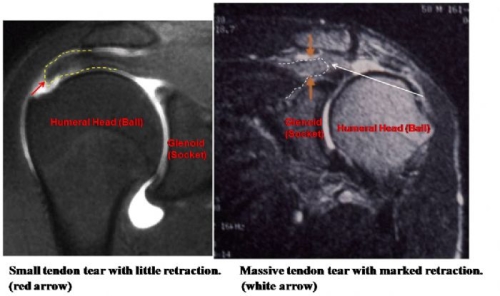
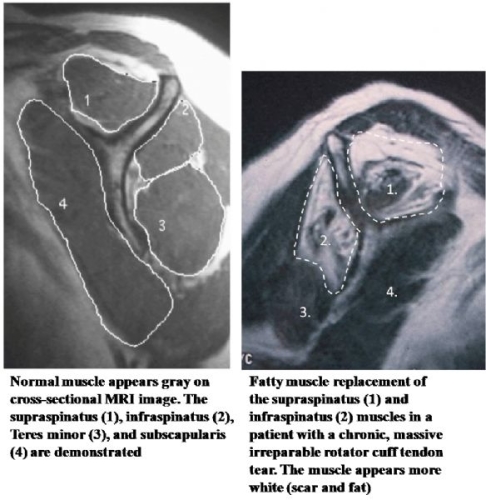
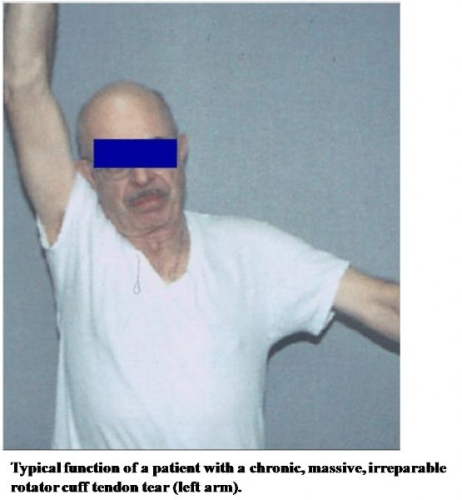
-
- Physical Therapy:In patients who have weakness which is not severe, physical therapy may improve pain and function by maximizing effectiveness of remaining muscles of the rotator cuff. Some patients actually may improve so they can place their hands overhead and have minimal pain.
- Arthroscopic Debridement & Biceps Tenotomy: Arthroscopy allows access to the shoulder joint through small incisions and may be performed as an outpatient procedure. Debridement means removal of loose tendon tissue and inflamed bursa which may be rubbing and causing pain. The biceps tendon is also often degenerated and as it slides up and down in the front of the shoulder it may be a cause of pain. Release of this tendon has been shown to relieve pain in many cases and its release does not compromise shoulder function.
- Arthroscopic or Open allograft (cadaver tissue) or xenograft (animal tissue): This is a method of treatment with variable outcomes as reported in the literature.
- Arthroscopic Partial Repair: This is generally reserved for patients who have reasonable function and are not profoundly weak.
- Arthroscopic Suprascapular Nerve Release (with or without rotator cuff repair): This is a method generally reserved for patients with pain felt over the top and back of the shoulder and in absence of another explanation for the pain.
- In some patients the suprascapular nerve may be tethered by retraction of the rotator cuff tendon tear. It’s release has been shown to give relief of pain and improve function in select patients. The nerve may also be decompressed where it runs underneath a tight ligament into the shoulder.
- Suprascapular Neuropathy Module
- Patient Testimonials: Suprascapular Nerve Decompression
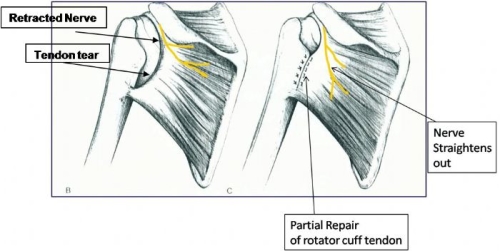
6. Tendon Transfer: This is a relatively rare procedure reserved for those patients with weak shoulders which are not so weak as to appear almost paralyzed (pseudoparalysis).
This procedure when performed for loss of the supraspinatus and infraspinatus involves transfer of the latissimus dorsi tendon from the back of the shoulder so that it can now substitute in function for the rotator cuff. This requires an incision in the back of the shoulder as well as the top of the shoulder.
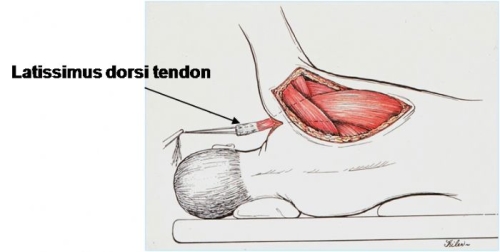
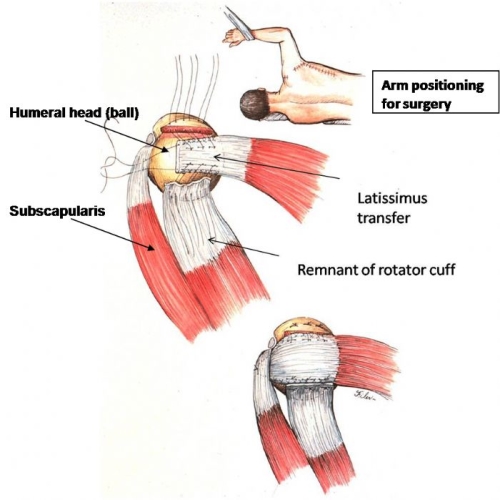
Latissimus Transfer: How well does it work?
Patient Before (massive rotator cuff tear) and 3 years after a latissimus dorsi transfer for an irreparable, massive rotator cuff tear.
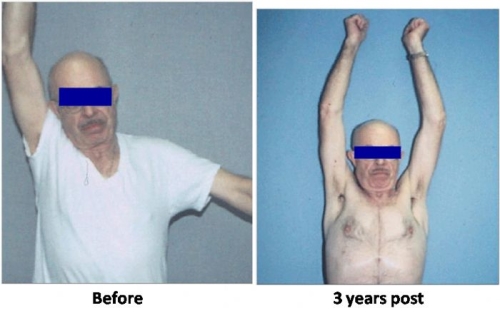
75-80% patient satisfaction after the surgical procedure
A few comments about Latissimus Dorsi Tendon Transfer:
-
- It is necessary to wear a special brace to keep the arm in a position away from the side so the tendon transfer can heal over 6 weeks
- A prolonged therapy program is required after surgery in order to train the tendon to function properly. This includes Biofeedback training
- The gains from the tendon transfer procedure may take up to one year to realize.
Latissimus Dorsi Transfer: Post-Operative Guidelines
Tendon Transfer for Irreparable Subscapularis Tendon Tear:
In these cases, the rotator cuff tendon in the front of the shoulder is torn and irreparable. In some cases, transfer of the pectoralis major muscle will improve function and alleviate pain.
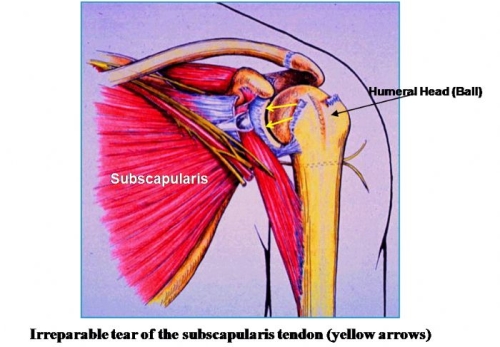
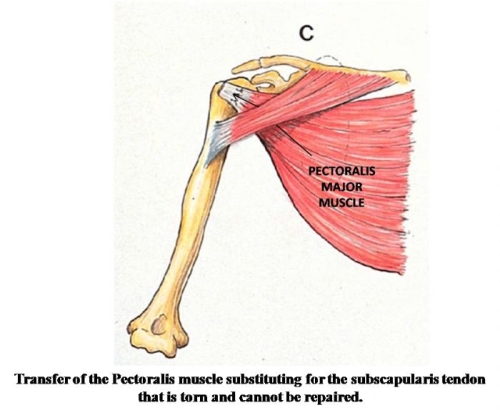 8. Reverse Prosthesis:
8. Reverse Prosthesis:
In patients with an irreparable rotator cuff tendon tear and weakness so severe that it is similar to a paralysis of the arm, a reverse prosthesis can be placed, which will not only facilitate improvement of motion, but also relieve pain. Details of this procedure are provided here: Reverse Prosthesis. This procedure basically provides a fixed fulcrum for rotation of the arm by reversing the position of the ball and the socket.
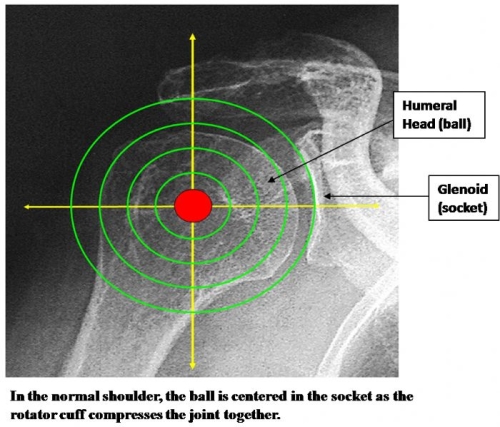
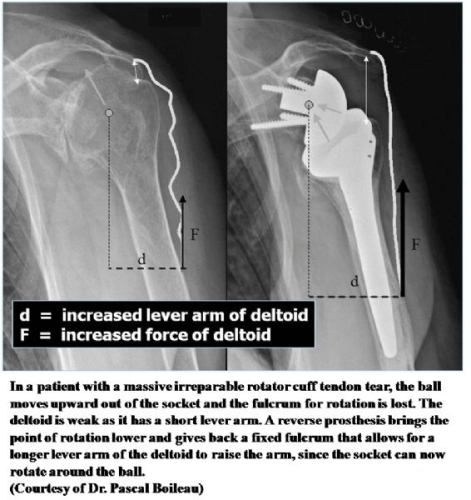
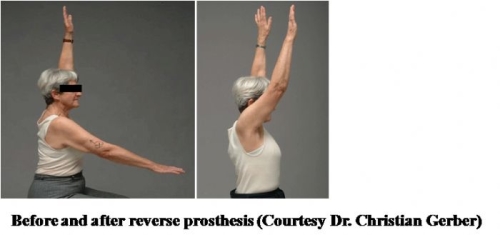
Sometimes a tendon transfer may be combined with a reverse prosthesis in order to improve motion. This video demonstrates a patient with poor function due to a massive rotator cuff tear and also arthritis. She had a reverse prosthesis with a latissimus dorsi, teres major tendon transfer and had an excellent outcome.
Patient Testimonials: Reverse Total Shoulder Replacement
Reverse Total Shoulder Replacement: Our Experience
Reverse Total Shoulder Replacement: Post-Operative Guidelines
Reverse Total Shoulder Replacement with Latissimus Transfer: Post-Operative Guidelines
New Approaches in Reverse Prosthesis: 3-Dimensional Planning
Irreparable Rotator Cuff Tendon Tear (Before and After)
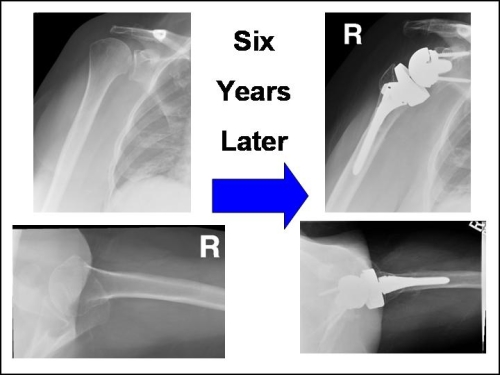

The surgery is performed with the patient lying on their opposite side and the latissimus dorsi tendon is taken from an incision in the back of the shoulder and then transferred underneath the deltoid and acromion bone into the top of the humerus (ball), in order to replace the torn and irreparable rotator cuff tendon.

The patient must wear a special brace for 6 weeks which keeps the arm out to the side so the tendon transfer can heal (Click here to view the physical therapy protocol for Latissimus transfer). After 3 months a program is instituted in order to train the tendon transfer to work properly (Click here to view video on tendon training of latissimus transfer).





Patient example
Pre-operative function
Post-operative function

- Chronic, retracted rotator cuff tendon tears with fatty degeneration of muscle cannot be repaired with reasonable expectation of healing.

- Smoking dramatically reduces healing after a rotator cuff repair.

- Pseudoparalysis is defined as inability to raise the arm above 90o or to the horizontal level. Many surgeons do not agree with this definition and instead believe it is the inability to raise the arm at all so that it looks as if it is paralyzed even though the nerves work normally. True pseudoparalysis in a chronic rotator cuff tendon tear cannot be reversed with a direct repair.

- 73% of patients who had a transplanted porcine xenograft for an irreparable rotator cuff tear had healing of the tendon graft.

- 83% of patients who had a reconstruction of the superior capsule performed arthroscopically had healing of the tendon and improved function. This is a small study which has not been reproduced at this time by other surgeons’ experience.

- 70% of patients who underwent Latissimus dorsi transfer in the absence of prior surgery were markedly improved in their function & their pain; however, only 55% were improved after this surgery if they had failed prior rotator cuff surgery.

- The results of Latissimus dorsi transfer for an irreparable rotator cuff tear are durable for 10 years and most patients had excellent improvement of both pain and function.

- Lower Trapezius transfer offers a promising alternative to Latissimus dorsi transfer and may provide similar results.
